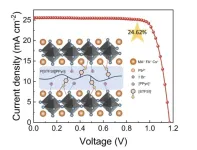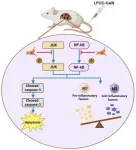(Press-News.org) The ability to regulate body temperature, a trait all mammals and birds have today, may have evolved among some dinosaurs early in the Jurassic period about 180 million years ago, suggests a new study led by UCL and University of Vigo researchers.
In the early 20th century, dinosaurs were considered slow-moving, “cold-blooded” animals like modern-day reptiles, relying on heat from the sun to regulate their temperature. Newer discoveries indicate some dinosaur types were likely capable of generating their own body heat but when this adaptation occurred is unknown.
The new study, published in the journal Current Biology, looked at the spread of dinosaurs across different climates on Earth throughout the Mesozoic Era (the dinosaur era lasting from 230 to 66 million years ago), drawing on 1,000 fossils, climate models and the geography of the period, and dinosaurs’ evolutionary trees.
The research team found that two of the three main groupings of dinosaurs, theropods (such as T. rex and Velociraptor) and ornithischians (including relatives of the plant eaters Stegosaurus and Triceratops), moved to colder climates during the Early Jurassic, suggesting they may have developed endothermy (the ability to internally generate heat) at this time. In contrast, sauropods, the other main grouping which includes the Brontosaurus and the Diplodocus, kept to warmer areas of the planet.
Previous research has found traits linked to warm-bloodedness among ornithischians and theropods, with some known to have had feathers or proto-feathers, insulating internal heat.
First author Dr Alfio Alessandro Chiarenza, of UCL Earth Sciences, said: “Our analyses show that different climate preferences emerged among the main dinosaur groups around the time of the Jenkyns event 183 million years ago, when intense volcanic activity led to global warming and extinction of plant groups.
“At this time, many new dinosaur groups emerged. The adoption of endothermy, perhaps a result of this environmental crisis, may have enabled theropods and ornithischians to thrive in colder environments, allowing them to be highly active and sustain activity over longer periods, to develop and grow faster and produce more offspring.”
Co-author Dr Sara Varela, of the Universidade de Vigo, Spain, said: “Theropods also include birds and our study suggests that birds’ unique temperature regulation may have had its origin in this Early Jurassic epoch.
“Sauropods, on the other hand, which stayed in warmer climates, grew to a gigantic size at around this time – another possible adaptation due to environmental pressure. Their smaller surface area to volume ratio would have meant these larger creatures would lose heat at a reduced rate, allowing them to stay active for longer.”
In the paper, the researchers also investigated if sauropods might have stayed at lower latitudes to eat richer foliage unavailable in colder polar regions. Instead, they found sauropods seemed to thrive in arid, savannah-like environments, supporting the idea that their restriction to warmer climates was more related to higher temperature and then to a more cold-blooded physiology. During that time, polar regions were warmer, with abundant vegetation.
The Jenkyns event occurred after lava and volcanic gasses erupted from long fissures in the Earth’s surface, covering large areas of the planet.
Co-author Dr Juan L. Cantalapiedra, of the Museo Nacional de Ciencias Naturales, Madrid, Spain, said: “This research suggests a close connection between climate and how dinosaurs evolved. It sheds new light on how birds might have inherited a unique biological trait from dinosaur ancestors and the different ways dinosaurs adapted to complex and long-term environmental changes.”
The study involved researchers from UCL, University of Vigo, the University of Bristol and the Museo Nacional de Ciencias Naturales in Madrid, and received funding from the European Research Council, the Spanish Ministry of Research, the Natural Environment Research Council and the Royal Society.
END
First ‘warm-blooded’ dinosaurs may have emerged 180 million years ago
The ability to regulate body temperature, a trait all mammals and birds have today, may have evolved among some dinosaurs early in the Jurassic period about 180 million years ago, suggests a new study led by UCL and University of Vigo researchers.
2024-05-15
ELSE PRESS RELEASES FROM THIS DATE:
Next-generation sustainable electronics are doped with air
2024-05-15
Semiconductors are the foundation of all modern electronics. Now, researchers at Linköping University, Sweden, have developed a new method where organic semiconductors can become more conductive with the help of air as a dopant. The study, published in the journal Nature, is a significant step towards future cheap and sustainable organic semiconductors.
“We believe this method could significantly influence the way we dope organic semiconductors. All components are affordable, easily accessible, and potentially environmentally friendly, which is a prerequisite for future sustainable ...
Disparities in patient portal engagement among patients with hypertension treated in primary care
2024-05-15
About The Study: This cohort study of patients with hypertension found clear sociodemographic disparities in patient portal engagement among those treated in primary care. Without special efforts to engage patients with portals, interventions that use patient portals to target hypertension may exacerbate disparities.
Corresponding Author: To contact the corresponding author, Rasha Khatib, Ph.D., M.H.S., email rasha.alkhatib@aah.org.
To access the embargoed study: Visit our For The Media website at this link https://media.jamanetwork.com/
(doi:10.1001/jamanetworkopen.2024.11649)
Editor’s Note: Please see ...
Dose-dependent association between body mass index and mental health and changes over time
2024-05-15
About The Study: This study revealed a U-shaped association between adolescent body mass index and mental health, which was consistent across sex and grades and became stronger over time. These insights emphasize the need for targeted interventions addressing body image and mental health, and call for further research into underlying mechanisms.
Corresponding Author: To contact the corresponding author, Shanquan Chen, Ph.D., email Shanquan.chen@lshtm.ac.uk.
To access the embargoed study: Visit our For The Media website at this link https://media.jamanetwork.com/
(10.1001/jamapsychiatry.2024.0921)
Editor’s ...
The doctor is in…. but what’s behind them?
2024-05-15
Americans have gotten used to seeing their doctors and other health care providers using telehealth video visits in the past four years. But a new study reveals that what a doctor has behind them during a telehealth visit can make a difference in how the patient feels about them and their care.
Even if the doctor is miles away from their usual in-person clinic or exam room, they should make it look like they’re there, the study suggests.
Even better: sitting in an office with their diplomas hanging ...
Structural evolution and high-temperature sensing performance of polymer-derived SiAlBCN ceramics
2024-05-15
The group of Gang Shao from Zhengzhou University, China recently investigated the structural evolution of pentagonal polymer-derived SiAlBCN ceramics (PDCs) and outlined PDC-based sensor technology for high-temperature extreme environments. The high-performance temperature sensing materials including high sensitivity, fast response, wide detection range are scarce and needful. This research developed a ceramic-based temperature with attractive performance that can be applied in high-temperature environments ...
An environmental CGE model of China’s economy: Modeling choices and application
2024-05-15
The general equilibrium framework of the CGE model widely used in cost-benefit analysis in the field of energy and environmental policy. Based on standard micro- and macroeconomic theories, the CGE model establishes quantitative connections between various sectors of the economy, enabling the examination of both direct and indirect effects resulting from exogenous changes in the economy, as well as their global impacts on the overall economy.
A team of energy economists by Yu Liu from Peking University in Beijing, China recently outlined the detailed content of their CGE model. This model is constructed based on the CGE model theory of the Australian Center ...
Adding polymerized ionic liquid improves performance of perovskite solar cells
2024-05-15
Perovskite solar cells, which use materials with the same crystal structure as perovskite, are lightweight, flexible, easy to manufacture, and inexpensive. They can be attached to many different surfaces and are a promising technology. However, current perovskite solar cells are not durable, and they tend to be inefficient. New research shows how additive engineering with a polymerized ionic liquid to the metal halide perovskite material can improve the solar cell’s function, helping to pave the way for the future wide adoption of perovskite solar ...
Half-matched family donors offer best outcomes for Hispanic patients undergoing bone marrow transplants
2024-05-15
LOS ANGELES — For adults with acute lymphoblastic leukemia (ALL), a type of cancer that originates in the bone marrow, allogeneic stem cell transplantation (more commonly known as a bone marrow transplant) may be necessary for survival. But for Hispanic patients, finding an identically matched donor within their family or through the bone marrow donor registry can be challenging, with only a 30% chance of finding a matching relative and a 48% chance of identifying a matching bone marrow donor through the national donor registry.
However, a new Keck Medicine of USC study in Leukemia ...
Alzheimer’s disease without symptoms. How is that possible?
2024-05-15
Everyone experiences aging in their own way, and factors such as genetics, lifestyle and environment play a role in this process. Some individuals reach the age of 90 or even 100 in good health, without medications or brain disease. But how do these individuals maintain their health as they age?
Luuk de Vries from Joost Verhaagen's group, and his colleagues Dick Swaab and Inge Huitinga, looked at brains from the Netherlands Brain Bank. The Netherlands Brain Bank stores brain tissue from more than 5,000 deceased brain donors with a wide range of different brain diseases. What makes the Netherlands Brain Bank so unique is that, in addition to the stored tissue with very precise ...
Mesenchymal stem cells alleviate acute liver failure through regulating hepatocyte apoptosis and macrophage polarization
2024-05-15
Background and Aims
Acute liver failure (ALF) is a life-threatening clinical problem with limited treatment options. Administration of human umbilical cord mesenchymal stem cells (hUC-MSCs) may be a promising approach for ALF. This study aimed to explore the role of hUC-MSCs in the treatment of ALF and the underlying mechanisms.
Methods
A mouse model of ALF was induced by lipopolysaccharide and d-galactosamine administration. The therapeutic effects of hUC-MSCs were evaluated by assessing serum enzyme activity, histological appearance, and cell apoptosis in liver tissues. The apoptosis ...
LAST 30 PRESS RELEASES:
Enriching framework Al sites in 8-membered rings of Cu-SSZ-39 zeolite to enhance low-temperature ammonia selective catalytic reduction performance
AI-powered RNA drug development: a new frontier in therapeutics
Decoupling the HOR enhancement on PtRu: Dynamically matching interfacial water to reaction coordinates
Sulfur isn’t poisonous when it synergistically acts with phosphine in olefins hydroformylation
URI researchers uncover molecular mechanisms behind speciation in corals
Chitin based carbon aerogel offers a cleaner way to store thermal energy
Tracing hidden sources of nitrate pollution in rapidly changing rural urban landscapes
Viruses on plastic pollution may quietly accelerate the spread of antibiotic resistance
Three UH Rainbow Babies & Children’s faculty elected to prestigious American Pediatric Society
Tunnel resilience models unveiled to aid post-earthquake recovery
Satellite communication systems: the future of 5G/6G connectivity
Space computing power networks: a new frontier for satellite technologies
Experiments advance potential of protein that makes hydrogen sulfide as a therapeutic target for Alzheimer’s disease
Examining private equity’s role in fertility care
Current Molecular Pharmacology achieves a landmark: real-time CiteScore advances to 7.2
Skeletal muscle epigenetic clocks developed using postmortem tissue from an Asian population
Estimating unemployment rates with social media data
Climate policies can backfire by eroding “green” values, study finds
Too much screen time too soon? A*STAR study links infant screen exposure to brain changes and teen anxiety
Global psychiatry mourns Professor Dan Stein, visionary who transformed mental health science across Africa and beyond
KIST develops eco-friendly palladium recovery technology to safeguard resource security
Statins significantly reduce mortality risk for adults with diabetes, regardless of cardiovascular risk
Brain immune cells may drive more damage in females than males with Alzheimer’s
Evidence-based recommendations empower clinicians to manage epilepsy in pregnancy
Fungus turns bark beetles’ defenses against them
There are new antivirals being tested for herpesviruses. Scientists now know how they work
CDI scientist, colleagues author review of global burden of fungus Candida auris
How does stroke influence speech comprehension?
B cells transiently unlock their plasticity, risking lymphoma development
Advanced AI dodel predicts spoken language outcomes in deaf children after cochlear implants
[Press-News.org] First ‘warm-blooded’ dinosaurs may have emerged 180 million years agoThe ability to regulate body temperature, a trait all mammals and birds have today, may have evolved among some dinosaurs early in the Jurassic period about 180 million years ago, suggests a new study led by UCL and University of Vigo researchers.







